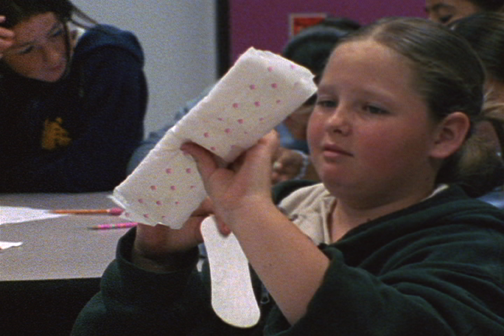 |
||||
Still from Period: The End of Menstruation? |
||||
Journal Issue 2.2
Fall 2010
Edited by Agatha Beins, Deanna Utroske, Julie Ann Salthouse, Jillian Hernandez, and
Karen Alexander
Editorial Assistant: Julie Chatzinoff
Period Piece. Directed by Jennifer Frame and Jay Rosenblatt. Harriman, NY: Jay Rosenblatt Films, 1996.
Period: The End of Menstruation? Directed by Giovanna Chesler. New York: The Cinema Guild, 2006.
Reviewed by Sharra L. Vostral
What
does menstruation mean? The documentaries Period Piece and Period: The
End of Menstruation, debuting ten years apart, address this question.
Both find that it is not so easily answered.
Period Piece focuses upon first periods — menarche — to create a
narrative about how puberty is negotiated in the United Studies in the
mid- to late-twentieth century. Co-directors Jennifer Frame and Jay
Rosenblatt arranged for girls, teens, adult women, and post-menopausal
women to be interviewed on-camera, the pink backdrop behind the
interviewees stylistic of the late 1980s and early 1990s. The women
represent a fairly diverse set of ethnic backgrounds, though regional
representation is not evident. The women’s various ages and cultures
offer nice attention to multiple perspectives, delivering both
retrospective accounts of first periods and prospective anticipation of
upcoming bodily changes.
At its
best, this short thirty-minute film provides examples of the various
manners in which girls are acculturated and come to learn about
menstruation, from detailed conversations with their mothers to general
denial and neglect of the whole subject by trusted adults. The event of
menstruation marks a shift in the body from child to adult, but more is
at stake in the transition from girl to woman. The interviewees
reflect on a gamut of emotions that they confronted at the time of their
first periods, ranging from happiness to sheer dread. One woman
remarked that she was elated and felt like saying “I am a woman!” upon
getting her period, but her excitement quickly dissipated with the more
onerous realization of limitations that were now hers to embody.
The film reveals the
real social pressures to look and be similar to other girls, including
the travails of menstruating early as an eight-year-old, the anxiety of
not menstruating and faking it by cutting skin to draw blood and wearing
a pad anyway, and the challenge of forging a different kind of
relationship with female caregivers and mothers. In the less poignant
moments, the film inserts clips from historical menstrual education
films, which often trivialize the very things that the film seeks to
legitimate. The historical footage requires far more contextualization
than the documentary is able to provide, and seems to lend a campy feel
to an otherwise tender treatment of women and their first periods.
Period: The End of
Menstruation? (54 min.) pays less attention to menarche and more to the
incessant medicalization of menstruation through various interventions.
Inherent to the approach of the film are the underlying but unstated
questions: What are the consequences of this medicalization? What does
it mean? And, who is resisting and how? This film, coupled with its
accompanying Web site (http://www.periodthemovie.com/), provides insight
to these questions.
In the film,
Giovanna Chesler, the director and producer, travels around the United
States to interview individual women and groups of women. Each segment
focuses upon a particular medical drama, and how women have reacted to,
interacted with, and contested the menstrual trouble before them. In
many cases, Chesler chose to voice the interviews over footage of the
women puttering about at home, instead of using more head-on shots of
the women telling their stories. The former technique distances the
interview subjects, but may also work to show how menstrual periods
become disembodied in the same way.
The interviews reveal deeply
held understandings about menstruation, and how individuals grapple with
conflicting advice, beliefs, and societal dictates. For example,
Jennifer, who goes by her first name, calls her monthly injection of
Depo Provera “the pregnancy vaccine” but she uses it instead to rid
herself of debilitating periods that once caused her to be hospitalized.
However, as a consequence of the treatments, her bones are weakened,
leached of calcium. Dr. Andrew Kaunitz, site tester for Seasonale,
espouses the benefits of a drug that offers only “four bleeding
episodes” per year, exemplifying the construction of menstruation as a
hassle, a burden, and unnecessary. Alice Dan from the Society of
Menstrual Cycle Research asks about the gaps in knowledge about not only
birth control but menstruation in general. As a female to male
transgender individual, Morty Diamond philosophizes about what it means
to have a period. And artist Geneva Kachman plays with the expectations
of a tampon dispenser in her exhibit to have it deliver chocolates
instead. There are many more interviews, each with its own take on the
problematic narratives of menstruation and the ways these constructions
are embedded in pharmaceutical, medical, and commodified understandings
of women’s bodies.
Both films
examined here address a real need for discussion by providing an opening
to air often silenced feelings and views. There are very few earnest
treatments of menstruation as a bodily and cultural phenomenon, and
these documentaries lend legitimacy to the serious questions about and
experiences of menstruation. Despite being produced over the span of a
decade, sadly, the films remain remarkably timely. They resonate with
still prevalent issues, concerns, and emotions about what it means to
live with and in a menstruous body.
Sharra L. Vostral is an associate professor at the University
of Illinois Urbana-Champaign and holds a joint appointment in Gender
& Women’s Studies and History. She has written Under Wraps: A
History of Menstrual Hygiene Technology1 , co-edited Feminist Technology2 , and is currently working on a cultural and technological history of Rely tampons and toxic shock syndrome.
Copyright © 2014. All rights reserved.